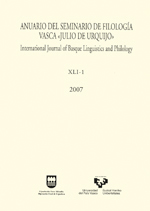Aditz jokatugabea eta "eta" enklitikoa
##plugins.themes.bootstrap3.article.main##
##plugins.themes.bootstrap3.article.sidebar##
Argitaratua
2007-04-12
Karmele Rotaetxe
Laburpena
In this article, an analysis and description is carried out of the non-finite verbal Basque forms compatible with the clitic eta. The description shows prosodic and semantic features together with grammatical ones (morphological and syntactic). In Basque grammars, there are three forms: the so-called "present participle" (represented by -t(z)en), that is, -t(z)en eta (described in Part 1), the so-called "aditz-oina", that is, aditz-oina eta (described in Part 2) and, finally, the perfect participle, that is, -tu eta (according with the normal representation in our grammar). The analysis of this last one is by far the most interesting. We prove that -tu eta constitutes a single word (Part 3) in which eta has been entirely agglutinated and functions as a suffixe (amaituta, not **amaitueta, for example). Because of its homophony, this form covers two grammatical units: a gerund (Part 4) and a past participle (Part 5). The gerund is used in two different structures: the absolute constructions and the conjunct construction. As for the past participle, we find it in the so-called Periphrase Structures (with ergative verbs as well as absolutive ones) and in two different structures related to the opposition of diathesis: the passive voice and the antipassive one. Our research shows that both share a basic feature that has never been pointed out in previous studies.
Nola aipatu
Rotaetxe, Karmele. 2007. «Aditz Jokatugabea Eta “eta” Enklitikoa». Anuario Del Seminario De Filología Vasca "Julio De Urquijo" 41 (1):323-35. https://doi.org/10.1387/asju.4323.
##plugins.themes.bootstrap3.article.details##
Zenbakia
Atala
Artikuluak
Lan hau Creative Commons Aitortu-EzKomertziala-LanEratorririkGabe 4.0 Nazioartekoa lizentzia baten mende dago.


